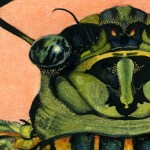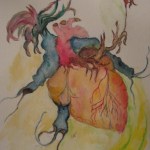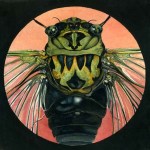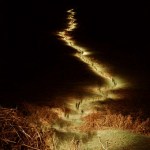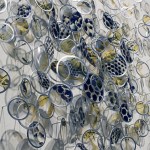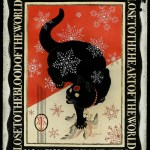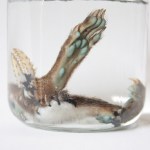Artists & Art
Recently a reader commented that my painting, Fall:The Cicada, is a little, um, insect-y. Yes, I have a propensity to paint insects-lots of 'em. I have a box of dead ones just waiting for the day I get around to painting them, so I thought I'd explain why. About the same time, I was encouraging a friend who is also an artist to start blogging about her works-in-progress. I don't have any works-in-progress at the moment, but I figured why not follow my own advice, so here you go: a post about painting insects.
I enjoy insects as subjects because they're like tiny jewels, each one with many…
Via reader-musician John Danley, I learned of Lori Anne Parker's "Watersketch Prospectus," "a yearlong project and response to a personal health crisis requiring heart surgery." As Danley observes, "her work is related to aesthetic responses to trauma."
After suffering a spontaneous coronary artery dissection, Parker was unable to work with her usual oils, and branched out into watercolor as a medium. Her weekly sketches, each completed in an hour and a half or less, are free-flowing fantasies filled with networks of vines/veins and anatomically inspired botanical imagery. They have a…
The UK History of Advertising Trust has initiated a ghostsigns archive to document old painted billboards - the kind you see on the sides of brick buildings, fading away unnoticed. These old signs are being destroyed daily (by gentrification, new construction, and new billboards being put over them), and very few new ones are being created (for an example, see my previous post on the artists behind the Stella Artois mural in NYC).
Unfortunately, preserving such signs permanently is difficult - and, some argue, not even desirable:
The core dilemmas are that they are not architectural…
[U]nlike artists or musicians, we do have competitors. Only van Gogh can paint like van Gogh and the uniqueness of Beethoven's music is immediately recognizable. Their contributions are irreplaceable. But individual scientists are not irreplaceable. There are many, many examples of important discoveries being made simultaneously by several individuals or groups working independently. The social scientists have all manner of explanations for this "phenomenon" but the bottom line is this: If I am not the first to discover, almost certainly someone else will be. No wonder we are so desperate to…
Over at scientificblogging.com, Mark Changizi has a post about "unconstrained scientific craziness":
I criticized avant-garde artists for their craziness, all the while explicitly aiming for craziness as a scientist! In effect, I was teaching my students to be avant-garde scientists, and trying myself to be an avant-garde scientist, yet somehow failing to notice that this outlook had transformative implications for my view of avant-garde art.Just like me, avant-garde artists are trying to be "crazy", hoping to make that next non-incremental advance. There's a method to the madness: the…
An urban art installation proposal by Nick Rodrigues would install sculpted pigeons in Cambridge, MA, each equipped with a "pico projector" that would project a live Tweet stream. According to the Artsake blog,
"Gossiping Birds" is a proposal by Nick Rodrigues (MCC Sculpture/Installation Fellow '07), one of ten artists chosen as finalists for a Public Art Commission in Cambridge, an initiative of the Cambridge Arts Council. The project called for site-specific public art proposals for the Cambridge Street Corridor, a one-mile stretch from Inman Square to Lechmere that spans three distinct…
I wanted to let you all know that I've put two framed original watercolor paintings up for sale on etsy: "Bee and Echinacea" (sold) and "The Cicada" (still available).
These are likely to be the only original paintings I'll have for sale for some time to come, so if you want a BioE original this is your chance. :)
Artist Balint Zsako does remarkable things with collage and biological/anatomical imagery. By embellishing his classically posed subjects with a plethora of arms, swaddlings of restrictive clothing, or provocatively opened fruit, he plays with our expectations: portraits become faceless, the suggestively private becomes public, and old-fashioned art becomes new again.
Whether it's we viewers stealing glimpses into bodies or between draperies, birds stealing seeds, or grasping hands matched perfectly to exogenous limbs, fruit, or instruments, Zsako's feverish imagery makes the very process…
Yes, they can! At least Tim Knowles thinks so: he attaches pens to the ends of branches and lets them doodle in the wind, like botanical spirographs.
Knowles says, "Like signatures each drawing reveals the different qualities and characteristics of each tree." It sounds cheesy, but it's true - the drawings really are distinct, and do capture something of the fluidity of a tree in the breeze.
Knowles' body of work is all about distinctive vectors and paths: he also did a series of "Vehicle Motion Drawings", and his "Postal Project" traces, seismograph-like, the movements of a package in…
Up There is a short documentary about the sign painters who still work in cities like New York, hand-applying mural-style ads to brick walls. In this short preview clip, you see an accelerated version of a series of murals painted over three weeks to advertise Stella Artois. Each image is drawn cartoon-style onto paper, holes are burned through the cartoon, and charcoal is applied to pattern the brick wall. Then the painters fill in the mural, mixing their paint as they go.
It's truly humbling to see such skilled painters, able to fill a wall with a proportional, almost photorealistic mural…
A recommendation from reader Calle: a time-lapse view of a Rocky Mountains park over a year, accompanied by sound bytes from the news. Occasionally pretty eerie.
News, Weather & Sports - a year long time-lapse documents the seasonal changes and the recreational activities of visitors to a public park. This is a preview clip of a looping video art project by Dan Hudson (www.danhudson.ca). Location: Canmore, Alberta, Canada. Music: Chris Jennings. Support: Canada Council for the Arts.
For the past two months, conceptual artist Jonathon Keats has been showing films . . . to potted plants.
Specifically, the flora will be seeing travel documentaries showing off glorious European skies. Will the green cinematic scheme backfire when the plants are too entertained to foresee their possible extinction?"Our destruction of the environment is bad news for plants," the brain-teasing Keats, who also pens Wired's Jargon Watch feature, said in an e-mail interview with Wired.com "I think it's only fair that shrubs and trees know what's happening, that they realize that the cataclysm…
Memento 2.9, 2009
Alan Bur Johnson makes delicate clustered sculptures that consist of transparencies in silver frames mounted on dissection pins: "The installations resemble haiku in their enchanting, simple grammar - and, like precise syllables come to luminous life as each framed, wing-like component flickers independently in the wake of an exhalation or current of air passing through the room." (source).
Much of the fragmented imagery Bur Johnson uses in his transparencies (honeycomb, dragonfly wing venation, segmented legs) is insectoid, and the pieces are correspondingly loose,…
Wednesday night, Radiolab's "science cabaret" program, Awe-mageddon, kicks off at 7pm with its first live video webcast, hosted by Jad Abumrad and Robert Krulwich:
"AWE-MAGEDDON" will feature Radiolab's trademark mash-up of world-class scientists, artists, philosophers and generally interesting people sitting down with Jad and Robert to explore the interdisciplinary nature of big ideas. For the first time ever, a Radiolab event can be experienced by audiences around the globe via live video webcast, available at www.wnyc.org/thegreenespace.
Their guests will be Iain Couzin, assistant…
Fellow lab rats, banish the lingering odor of LB broth from your nostrils and imagine how awesome research would be if these little cuties were your model organisms!
Buy them from Specimen7 on MakersMarket.
I blogged about Lisa Black's steampunk heart:
Fixed Heart
offal with mixed metal components
Lisa Black, 2008
I blogged about New Zealand artist Lisa Black before, but I can't get over this great piece of hers. What does it signify? Does it represent the gradual replacement of the natural world around us with technology, to the point where our own bodies become artificial? Is it critiquing the reductionist tendencies of neurobiologists who believe our deepest emotions are complex but purely chemical reactions? Is it a steampunk Valentine? I don't know, and I don't really care - it's just cool…
A fun poster by editorial artist Harry Campbell (you've no doubt seen his work in the NYT and elsewhere). Love the cut-aways and perspective changes - it reminds me of a children's book.
C.B., circa 1708: "These color circles, from a 1708 edition, are the earliest published examples of Newton-style color circles in an artist's manual."
Moses Harris, 1766: "Mimicking the spread of light from a source, Harris places the pure colors at the center of his circle and the lightest at the outer edge."
Schiffermuller, 1772: "Like many others with the same goals, he assumed that there is a knowable natural order to color, one that would confirm the relationship among all forms of knowledge."
More quotes and images from Sarah Lowengard's e-book The Creation of Color in 18th Century…
Chauncey
Christopher Conn Askew
Christopher Conn Askew's intensely graphic artwork is like military propaganda from 1984. Anthropomorphized, vaguely threatening domestic animals, particularly cats, mingle with children, nudes, badges, weapons, and typography for a sinister yet delightful effect. I COVET his latest print, Upon a Tiny Throne:
How awesome is that? It's a limited edition of only 200 prints; don't tell me if you get one because I'll be insanely jealous!
Via She Walks Softly.
Nate Hill has a strong stomach and, er, unique artistic vision: he likes to cobble sculptures together out of dead animal parts. While his "New Animals" are the sort of clever, genteel, well-sealed artifacts you might find in a trendy loft belonging to a medical illustration enthusiast, his "ADAM Project" is rawer: it's a life-size human figure made of meat. Lots of fishheads. With chicken head genitalia.
No, not genteel at all. Looks like some of the gallery visitors felt a bit faint. No wonder he calls his website "Nate Hill is Nuts".
Thanks to Tom for this one.
